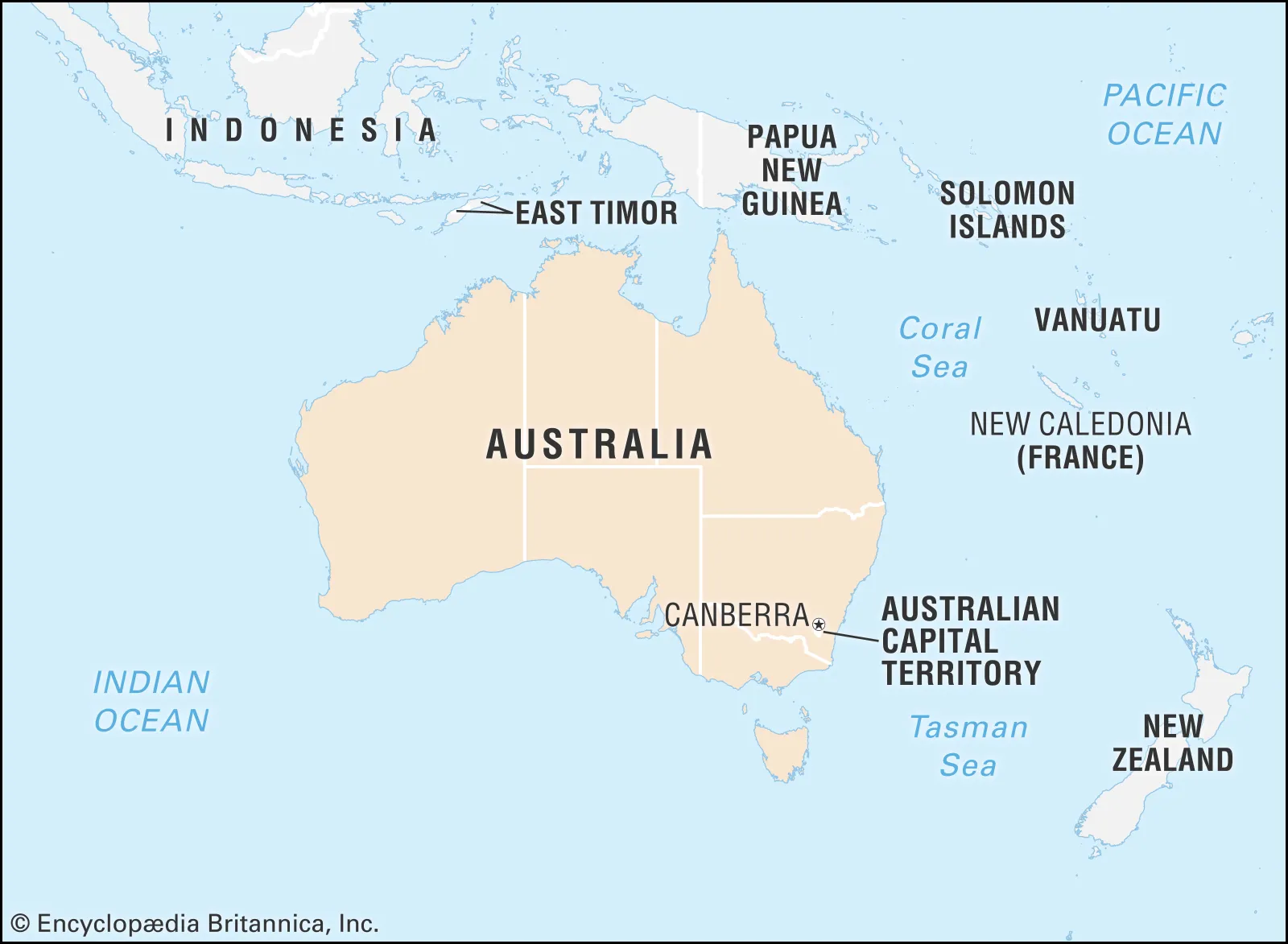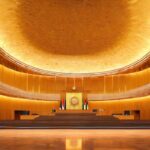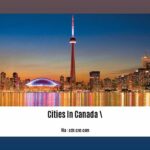Many people are surprised to learn that Sydney, despite its iconic Opera House and Harbour Bridge, isn’t the capital of Australia. Neither is vibrant Melbourne, known for its coffee culture and laneways. The honor goes to Canberra, a city nestled in the southeastern part of the country.
What is the Capital City of Australia?
Canberra, the capital of Australia since 1913, embodies the nation’s federal spirit, serving as a neutral territory between the rivaling cities of Sydney and Melbourne. After Australia’s federation in 1901, a compromise led to the creation of a new capital in New South Wales, at least 100 miles from Sydney. Canberra was established as the capital in 1913, representing a neutral ground between the rival claims of Sydney and Melbourne.
Designed by American architects Walter Burley Griffin and Marion Mahony Griffin, Canberra is a meticulously planned city featuring symmetrical geometric motifs and landmarks aligned with its mountainous surroundings. American architects Walter Burley Griffin and Marion Mahony Griffin won an international design competition in 1911. Their plan for Canberra emphasized geometric motifs and axial alignments with significant landmarks, creating a distinctive urban landscape.
As the seat of the Australian government, Canberra hosts numerous federal institutions, national monuments, and cultural attractions, making it a hub for politics, history, and the arts. Canberra is the seat of the Australian Government and houses the Parliament, Government House, and High Court. It is home to numerous national monuments (Australian War Memorial) and cultural institutions (like the Australian National University, National Gallery, and National Museum).
Despite its status as a planned city, Canberra has evolved into a vibrant and cosmopolitan metropolis, with a diverse population and a thriving economy in various sectors beyond government employment. While the Commonwealth Government remains a major employer, Canberra has diversified its economy in healthcare, education, and retail. It has a higher tertiary education rate, lower unemployment, and a younger population compared to national averages. Canberra has been recognized as a top livable and visitable city globally, attracting a diverse population with 32% born overseas.
So, how did Canberra come to be the capital? Well, imagine it’s the early 1900s, and Australia is just starting as a nation. Sydney and Melbourne, already bustling cities, both wanted the title of capital. The rivalry was real! To keep things fair and prevent any hard feelings, they decided on a compromise: a brand new city, built right between Sydney and Melbourne. And that’s how Canberra was born in 1913.
But Canberra isn’t just some compromise city. It was meticulously planned by American architects, Walter Burley Griffin and Marion Mahony Griffin, who won an international competition for their vision. They imagined a city that blended seamlessly with the surrounding mountains and nature, incorporating geometric patterns and aligning landmarks in a way that feels both grand and deliberate.
As you can imagine, being Australia’s capital means Canberra is a hub for all things government. Parliament House, where laws are made, is a sight to behold. Government House, the official residence of the Governor-General, is another impressive building. And then there’s the High Court of Australia, the highest court in the land, known for its distinctive architectural style.
But Canberra isn’t all about politics and governance. It’s also home to some of Australia’s most important cultural institutions. The Australian War Memorial, for instance, is a poignant reminder of the sacrifices made by Australians in past conflicts. And if art is more your thing, you’ll want to check out the National Gallery of Australia, with its impressive collection of Indigenous and international art, or the National Museum of Australia, which tells the story of Australia’s rich history and culture.
In recent decades, Canberra has shed its image as a sleepy government town and transformed into a vibrant and cosmopolitan city. While the government remains a major employer, the city has diversified its economy, attracting businesses in healthcare, education, and other sectors. This has led to a younger population, with a higher percentage of people holding university degrees compared to the national average.
So, what’s it like to actually live in Canberra? Well, many residents will tell you it offers a fantastic quality of life. The city is surrounded by nature, with plenty of parks and green spaces to explore. It also boasts a thriving food and wine scene, as well as a calendar full of festivals and events.
Canberra truly is a unique city. It’s a testament to thoughtful urban planning, a blend of history and modernity, and a place where nature and culture intertwine. Next time you think of Australia, don’t forget about Canberra, the often-overlooked but truly remarkable capital city.
Are you interested to know about the administrative divisions of a specific country? If so, check this out: capital of kazakhstan.
A capital city plays a significant role in various aspects of a country’s administration and political structure. To learn more about the administrative centers of different countries, refer to these resources: capital of madagascar, capital of albania, capital of cambodia, what is the capital of norway, capital of bhutan, capital of taiwan.
Additionally, if you’re looking for a comprehensive guide to the capital cities of Canada, this resource provides a detailed list and descriptions of each capital.
What is capital city Australia?
So, you’re curious about Australia’s capital city? Well, it’s not Sydney or Melbourne, as many people might guess! Australia decided to go with a wildcard and chose Canberra. Why Canberra, you ask? It all started back in 1913. See, Sydney and Melbourne were in a bit of a rivalry – both thought they should be the capital. To keep things fair (and maybe avoid some hurt feelings), they decided on a compromise: a brand new city, built just for the job.
Canberra popped up in the Australian Capital Territory, a special area nestled within New South Wales, about a 250-kilometer drive southwest of Sydney. They wanted Canberra to be something special, so they brought in some talented American architects to design it. These architects were all about geometric shapes and making sure the city lined up perfectly with important landmarks – pretty cool, right?
These days, Canberra is a bustling city with a diverse population. It’s not just about politics, though. Sure, it’s the heart of the Australian government, but it’s also become a hub for art, history, and culture. Think museums, galleries, and maybe even a festival or two!
Does Australia Have Two Capitals?
You know how some rumors just refuse to die? Well, the idea of Australia having two capitals is one of them. While it’s a fun thought to entertain, the truth is much simpler: Australia has only one capital city, and that’s Canberra.
The confusion likely comes from the historical rivalry between Sydney and Melbourne. See, before Canberra came into the picture, these two bustling cities were locked in a constant tug-of-war for the title of Australia’s capital. It was like a sibling rivalry that played out on a national scale!
To put an end to the bickering and find a solution everyone could (somewhat) agree on, the Australian government took a page out of Solomon’s book and decided on a neutral location. Thus, Canberra was born in 1911, strategically nestled in the Australian Capital Territory (ACT). It was a bit like creating a whole new playground to stop kids from fighting over the old one.
And Canberra isn’t your average city; it was meticulously planned from the ground up. Think of it like this: if cities were cakes, Sydney and Melbourne might be those delicious, but slightly messy homemade ones. Canberra, on the other hand, is the perfectly sculpted, multi-tiered masterpiece you’d find in a fancy bakery window. Its design, heavily influenced by the modernist movement of the early 20th century, features wide, tree-lined avenues, geometric layouts, and a whole lot of open spaces. It’s a city built for contemplation and, of course, governing a nation.
While Canberra might have started as a compromise, it has blossomed into a vibrant and dynamic city in its own right. As the seat of the Australian Parliament and home to key national institutions like the National Gallery of Australia and the National Museum of Australia, Canberra plays a crucial role in shaping the country’s political and cultural landscape.
This isn’t to say those other contenders, Sydney and Melbourne, are out of the game entirely. They remain cultural powerhouses, each with its own distinct personality and charm. Sydney boasts the iconic Opera House and Harbour Bridge, while Melbourne thrives with its art scene and coffee culture (seriously, Melbourne takes its coffee very seriously!).
So, while you might hear whispers about Australia having two capitals, remember it’s just not true. Canberra holds the official title and wears the crown with pride. But hey, that doesn’t mean you can’t explore the unique personalities of Sydney, Melbourne, and all the other amazing cities Australia has to offer!
Why is Sydney no longer the capital of Australia?
So, you might be surprised to know that Sydney, despite being super famous and all, isn’t actually the capital of Australia. That honor goes to Canberra. And it’s not just a random choice! It all boils down to a bit of a historical compromise. You see, back in the day, Sydney and Melbourne were like the two popular kids in school, always vying for attention. They both thought they should be the capital. To avoid a full-blown rivalry and keep things fair, they decided to find a neutral ground, a place that wouldn’t play favorites.
That’s where Canberra comes in! Founded in 1913, it was strategically placed between Sydney and Melbourne, like a peace offering. This move helped unite the young nation and avoid any hard feelings. Think of it like this: if you have two friends who both want the last slice of cake, the fairest thing to do is cut it in half, right? That’s kind of what happened here, just with cities instead of cake.
Now, just because Canberra became the capital doesn’t mean Sydney lost its sparkle. Sydney’s still Australia’s oldest city and a total magnet for tourists with its iconic Opera House and Harbour Bridge. It’s a cultural hub, a financial center, and let’s be real, it’s just plain cool.
Canberra, on the other hand, embraces its role as the political heart of Australia. It’s where the big decisions are made, where Parliament resides, and where you’ll find important institutions like the Australian War Memorial. Think of it as the serious, organized friend who keeps everyone on track.
The story of why Canberra became the capital is a reminder that sometimes the best solutions come from compromise and finding common ground. It’s a testament to Australia’s ability to find unity and balance, even when faced with tough choices.
Is Melbourne Australia a capital city?
So, you’re curious about Melbourne? It’s easy to see why! This bustling city in southeastern Australia is definitely a big deal. It’s the capital of the state of Victoria and is known for its vibrant arts scene, delicious food, and love for sports. But when it comes to being the capital of all of Australia? That’s where things get interesting.
Melbourne is a major player, no doubt, but the title of Australia’s capital city belongs to Canberra. You see, back in the day, there was a bit of a friendly rivalry between Sydney and Melbourne. Both cities had a strong claim to being the capital, and things probably got a little heated! To find a solution everyone could agree on, a decision was made to build a brand new capital city from scratch. And that’s how Canberra, located in the Australian Capital Territory, came to be.
Canberra’s location wasn’t just a random choice either. Situated between Sydney and Melbourne, it was strategically planned to be a neutral ground, a symbol of unity for the entire nation. Plus, its modern design and layout were meant to embody a fresh start for the young country.
Think of it this way: Melbourne is like the popular kid in school, the one everyone knows and loves for their vibrant personality. Canberra, on the other hand, is like the class president, chosen for their ability to represent everyone fairly and keep things running smoothly. Both important in their own way!
So, while Melbourne might not be the capital of all of Australia, it’s definitely a city with a whole lot to offer. And hey, there’s no rule saying you can’t have a favorite city, even if it’s not the one on the official paperwork, right?
Is Melbourne or Sydney the Capital?
So, you’re curious about Australia’s capital? It’s a question that often trips people up! You see, it’s not Sydney, even though it’s the first city that pops into many people’s minds when they think of Australia. And it’s not Melbourne either, despite its rich history and vibrant culture.
The honor of being Australia’s capital goes to Canberra. “Canberra?” you might be thinking, “Where’s that?”. Well, it’s actually located smack-dab between Sydney and Melbourne. Talk about a perfect compromise, right? You see, back in the day, there was a bit of a rivalry brewing between Sydney and Melbourne. Both cities had a strong claim to being the capital, and let’s just say they weren’t shy about it! To avoid any hard feelings, they decided on a neutral location, a place where neither city would feel like it had the upper hand. And that’s how Canberra came to be the capital of Australia in 1927.
Canberra isn’t just some random spot on the map, though. It was carefully planned and designed to represent the spirit of a united nation. Think grand avenues, impressive monuments, and buildings that scream “We’re here to govern!”. It’s a city that embodies the idea of coming together, of finding common ground.
Now, don’t get me wrong, Sydney and Melbourne are still amazing cities in their own right. Sydney, with its dazzling harbor and iconic Opera House, is a global city bursting with life and energy. It’s a place that knows how to put on a show and leave you breathless.
Melbourne, on the other hand, is known for its artsy vibe, its coffee culture, and its hidden laneways just waiting to be explored. It’s a city that invites you to slow down, savor the moment, and discover its hidden treasures.
So, while neither Sydney nor Melbourne snagged the coveted title of Capital City, they continue to captivate hearts and minds as two of Australia’s most beloved and iconic cities. And Canberra? Well, it stands proud as the symbol of a nation united, a testament to compromise and collaboration.
Is Perth the capital of Australia or Sydney?
Okay, let’s clear up any confusion! You might be surprised to know that neither Perth nor Sydney holds the title of Australia’s capital. That honor goes to a city called Canberra.
You see, back in the early 1900s, there was a bit of a rivalry brewing between Sydney and Melbourne – both bustling cities vying for the top spot. To settle the debate and avoid any hard feelings, the Australian government decided to create a brand new city to serve as the nation’s capital. And so, Canberra was born!
Now, even though Canberra is the capital, Sydney is still a super important city in Australia. It’s actually the most populated city in the country and known for its iconic landmarks like the Sydney Opera House. As for Perth, it’s no slouch either! Perth is the vibrant capital of Western Australia, a massive state known for its stunning coastlines and outback landscapes.
Think of it this way: Australia is divided into states and territories, kind of like different regions within a country. Each state and territory has its own capital city, usually the biggest and busiest city in that region. So, Sydney is the capital of New South Wales, Perth is the capital of Western Australia, and Canberra stands as the capital of the entire country!
Is Brisbane a Capital City?
So, you’re curious about Brisbane’s status in the land of Oz? We’ve already established it’s a bustling hub, but some folks get tripped up on whether it’s the capital city. Here’s the lowdown: While Brisbane is undoubtedly a VIP in its own right, wearing the crown of Queensland’s capital, it doesn’t quite reach the top spot for the entire country.
Think of it this way: Australia’s like a team with star players. Brisbane is definitely a leading scorer, representing Queensland with pride as its capital and holding its own as the third most populous city in the whole country! But for the big league title of national capital, we turn to Canberra.
Why Canberra, you ask? Well, back in the day, when Australia was figuring things out, there was a bit of a sibling rivalry brewing between Sydney and Melbourne. Each had a strong claim to the title, and things were getting a tad tense. To keep the peace (and maybe avoid some epic Aussie Rules Football brawls!), they decided on a neutral ground – Canberra – as the official capital in 1913.
It was a strategic move, fostering unity and preventing any bruised egos. So, while Brisbane continues to shine as Queensland’s vibrant heart, Canberra carries the torch for all of Australia. It’s a bit like having a captain and a co-captain – both important, just with slightly different roles.
This interesting tidbit about Canberra often sparks curiosity about capital cities in general. It reminds us that these designations are rarely arbitrary. They often reflect historical events, geographical considerations, and even a touch of political maneuvering. So next time you’re pondering a city’s status, remember there’s often a fascinating story behind the label!
Is Sydney the capital of anything?
So, we’ve established that Sydney isn’t the capital of Australia. But hold on, before you go thinking it’s just another pretty face, Sydney does wear a very important crown! You see, back in 1788, it was chosen as the capital city of New South Wales, which just so happens to be the most jam-packed with people of all of Australia’s states. Think of it like this: if Australia was a high school, New South Wales would be the biggest clique, and Sydney? Well, Sydney would be the undisputed leader of that pack.
But the story doesn’t end there. See, while Sydney might be a total rockstar in its own right – an “Alpha city” even, fancy that! – the title of Australia’s national capital went to a city built specifically for the job: Canberra. Picture this: a whole city, carefully planned and plonked right between Sydney and Melbourne – almost like someone trying to stop a sibling rivalry before it even started. It was a strategic move, really. Canberra, with its central location and squeaky-clean image, was meant to represent all of Australia, not just one state or another.
Think of it like this: Canberra is like the brain – the organized, efficient center of it all – while Sydney is more like the heart – vibrant, energetic, and full of life. Both are important in their own unique ways, right?
But wait, there’s more!
Here’s where things get really interesting. Some folks argue that Sydney, with its booming economy and global influence, might actually be a kind of unofficial capital. Now, this isn’t something you’ll find in a textbook, but it’s a fun thought to chew on. After all, Sydney is a major player on the world stage – a magnet for businesses, tourists, and bright minds from all over.
So, what’s the takeaway?
Sydney might not be the official capital of Australia, but it’s definitely a city that wears many hats. It’s a state capital, a global powerhouse, and a cultural melting pot – all rolled into one. And who knows, maybe someday, the lines between “official” and “unofficial” will blur even further. After all, cities, just like people, are constantly evolving, right?
What is the capital city?
Picking up from our earlier discussion, let’s delve a bit deeper into what makes a capital city. Think of it as the main headquarters for a country or even smaller regions within a country. It’s where all the important government buildings are, and where leaders meet to make decisions.
The word “capital” itself gives us a clue – it comes from the Latin word “caput,” meaning “head.” This makes sense, right? The capital is like the head of the country, guiding and directing everything.
Now, you might be thinking that the capital city is always the biggest or the busiest city. While that’s sometimes true, it’s not a hard and fast rule. Throughout history, all sorts of things have influenced where capitals popped up and how they developed. Sometimes it was about where the money was flowing, other times it was about strategic location, and sometimes it was a mix of both.
What we know for sure is that the locations of capital cities are rarely random. They are chosen carefully, often reflecting the history, power dynamics, and even the ambitions of the people they represent. It’s a fascinating subject, and researchers are constantly digging deeper into the stories behind these important cities.
What is Australia’s capital and its nickname?
Alright, so we know Sydney and Melbourne are the big names in Australia, always duking it out, right? But when they were deciding on a capital city, things got a little… complicated. They needed a place that wouldn’t spark any jealousy. Enter Canberra!
Canberra is like that friend who’s always neutral when drama pops up. It’s located smack-dab in between Sydney and Melbourne, nestled within a special territory called the Australian Capital Territory. This way, no one feels left out, and everyone’s happy. The word “Canberra” itself comes from the language of the Aboriginal Australians, meaning “meeting place.” Makes sense, given its role as a unifying point for the entire nation.
Now, about that nickname – “Oz.” It’s short, catchy, and just rolls off the tongue. Think of it as a term of endearment for the whole country. You see, Australia is often referred to as “down under” because of its location in the Southern Hemisphere. “Oz” captures that unique identity, kinda like a secret code word for a place full of sunshine, adventure, and maybe a few kangaroos hopping around.
- SYBAU See You Baby Meaning: Gen Z Slang Evolves - July 1, 2025
- Unlock Your Inner Youth: Lifestyle Secrets for a Vibrant Life - July 1, 2025
- Decode SYBAU Meaning: Gen Z Slang Explained - July 1, 2025







4 thoughts on “Unveiling the Enigma: Discovering the Capital City of Australia”
Comments are closed.